
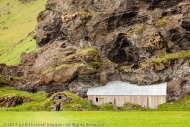
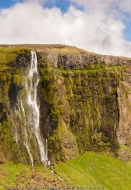
Hetch Hetchy. What a funny name, I thought. What is it and why would I want to go to a photo workshop there, with gorgeous Yosemite Valley right down the road?
The year was 2008 and I was just getting back into serious photography, this time in a digital world. I thought a couple of instructor-led workshops in Yosemite National Park would be a perfect way to ease back into what had been a serious career possibility at one time. (I had once been interested in photojournalism, favoring news and sports photography, but now I found nature to be a more interesting subject.) I had already noticed an interesting workshop timed to coincide with a good opportunity to photograph a “moonbow” at Yosemite Falls, which I’ve already described in this article. But that’s only one evening. What else to do while there?
I noticed a whole collection of events, including a couple of photo workshops, centered around this thing called Hetch Hetchy. It seems that Hetch Hetchy is a valley in Yosemite National Park that was at one time so beautiful that it was considered a twin to Yosemite Valley. I say at one time because now it is completely underwater, the casualty of the O’Shaughnessy Dam completed in 1923 to contain the Tuolumne River and create the Hetch Hetchy Reservoir for the city of San Francisco water supply. (Speaking of casualties, the famous naturalist, author, and preservationist, John Muir, was an opponent of the dam project, and died shortly after losing the battle to stop it, some say of a broken heart.) And this monstrosity is inside a national park. You’re kidding, right? I’ve gotta check this out for myself.
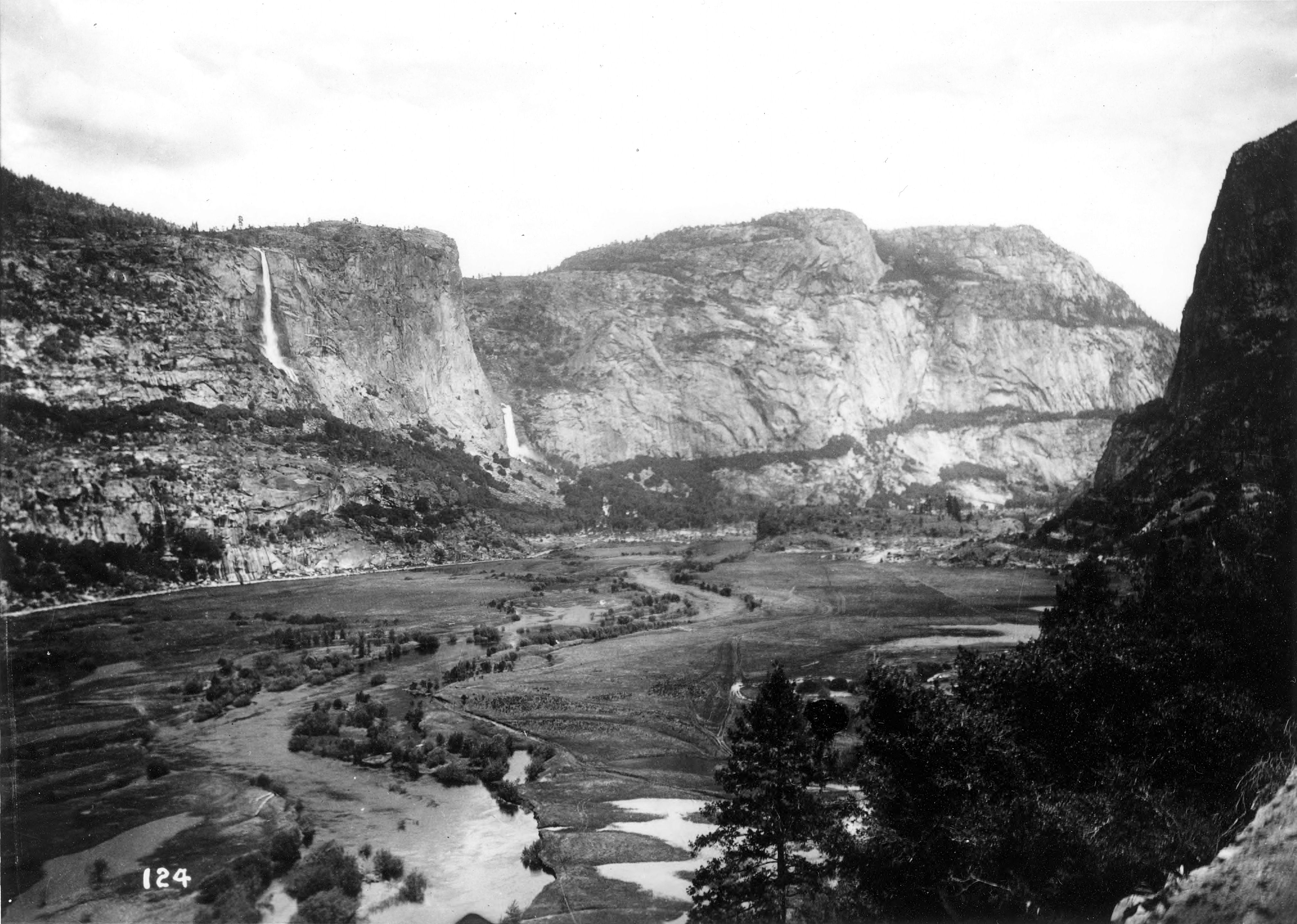
“Hetch Hetchy Valley” by Isaiah West Taber – Sierra Club Bulletin, Vol. VI. No. 4, January, 1908, pg. 211 [1]. Licensed under Public Domain via Wikimedia Commons.
So I signed up for two photo workshops given by different instructors, hoping to get some varying insights on photographing nature, as well as differing light, as one was in the morning and one in the evening. I also made plans to attend lectures and seminars given by current day opponents of the dam. The Sierra Club remains opposed to the dam as they did in John Muir’s day, but are now joined by Restore Hetch Hetchy, an organization dedicated to the undoing of what they call “this great American mistake”.
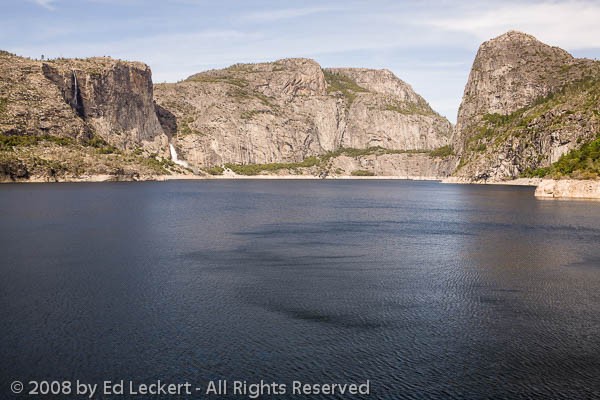
The once-beautiful Hetch Hetchy Valley, considered by John Muir to be a twin valley to Yosemite Valley, now sits at the bottom of the Hetch Hetchy Reservoir, flooded to become part of the San Francisco water supply, in Yosemite National Park, California.
I’m not going to lie to you – as far as photo shoots go, I was not inspired by this one at all. Our group marched out onto the old O’Shaughnessy Dam at about 8 AM, on the early side, yes, but the light was already harsh. On our left, what of the Tuolumne River was allowed to flow toward San Francisco disappeared down a drainage, and to our right, a huge, man-made lake. The only thing missing was the motor boats and skiers and swimmers, which thankfully are not allowed, due to concerns about pollution. The water flowing into the reservoir is so pure, it would not even be filtered before use by San Francisco residents.
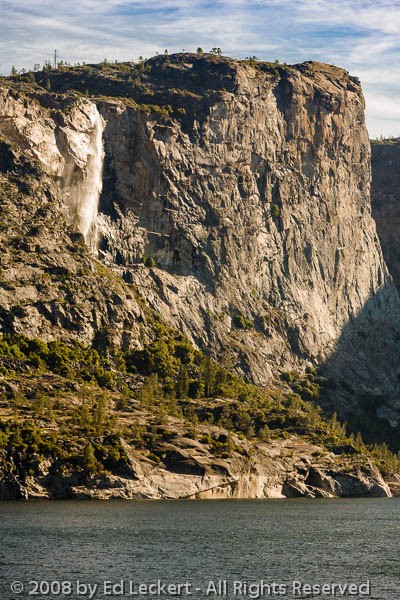
This granite monolith in the Hetch Hetchy Valley of Yosemite National Park looks remakably similar to a rock formation only several miles away known as El Capitan. It was even more striking before construction of the O’Shaughnessy Dam flooded this beautiful valley, in Yosemite National Park, California.
While standing on the dam, our instructor asked us to look across the lake at a huge granite wall and asked us if it looked familiar. Why yes, it does. It looks a lot like El Capitan, the famous monolith just a few miles south in Yosemite Valley. Looking at that formation and at paintings and photographs taken prior to the flooding of the valley, it’s easy to see why John Muir called this Yosemite Valley’s twin. Looking at the rest of it in its current flooded state, unfortunately, there’s no comparison any more.
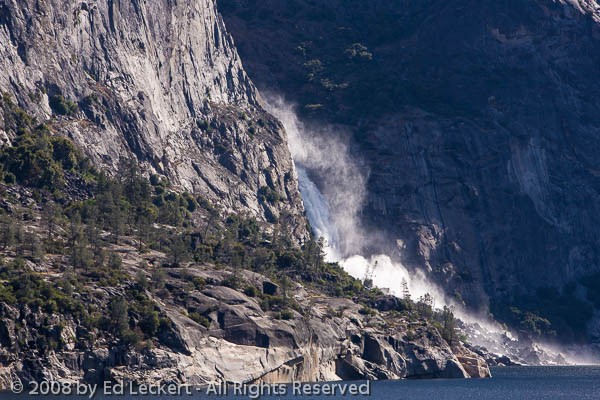
Wind whips up a waterfall beside the Hetch Hetchy Reservoir, sending spray across the trail, in Yosemite National Park, California.
After crossing the dam, the trail continues along the north shore of the lake, past a couple of waterfalls, which we stopped to photograph on both outings. One of the falls was close to the trail, and with the wind whipping the water back and forth, created so much mist and spray that we had to run past with our gear covered to keep from getting everything soaked. If fact, on the way back, just after leaving the group early to rush to get to my “moonbow” workshop that evening, my pack cover blew off. The workshop leader, Christine White Loberg, ran after me with it, yelling. She’ll always remember me as the guy who made her do a relay hand-off with the pack cover, which she found hilarious. Whenever I return to the park, I try to locate my workshop leaders from this trip, both of whom work at the Ansel Adams Gallery there. The relay hand-off is how I remind her who I am, and her face always lights up at the silliness of it all.
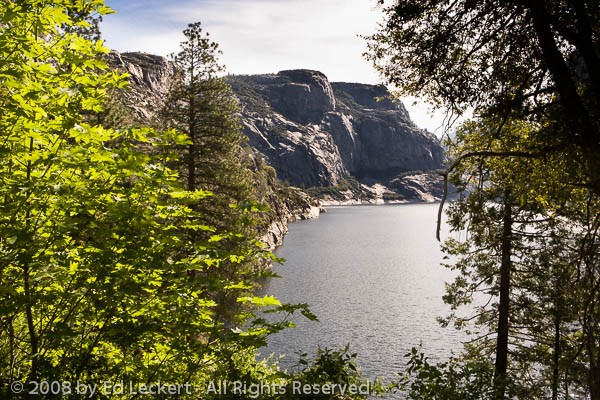
The once-beautiful Hetch Hetchy Valley, considered by John Muir to be a twin valley to Yosemite Valley, now sits at the bottom of the Hetch Hetchy Reservoir, flooded to become part of the San Francisco water supply, in Yosemite National Park, California.
So I know what you’re thinking. It’s not so bad. Look at the beautiful plants and trees, rock formations, and at the end of the day it’s still a lake, man made or not. Lakes are pretty.
Well, that’s true to a point. But no one is ever going to confuse a pretty little alpine lake with a flooded valley, a huge ugly dam on one end and bathtub rings all around. Every photo above, but especially this next one, shows an ugly ring, but more than that, if you’ve spent any time in nature, you know valleys just don’t fill like this naturally.
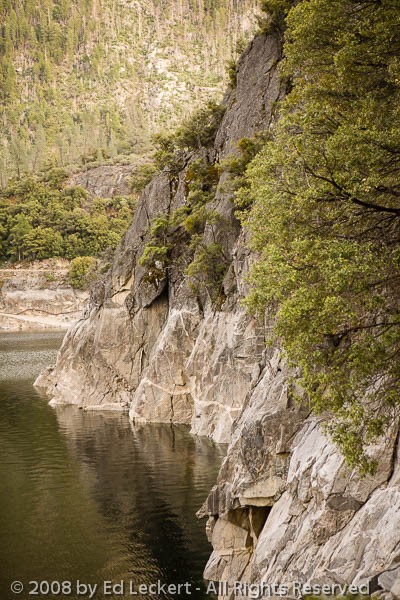
The annual rise and fall of the water level in the Hetch Hetchy Reservoir leaves ugly “bathtub rings” around the edge of this reservoir inside a national park, in Yosemite National Park, California.
This is not natural, and your mind senses that immediately. We return to nature to get away from man-made ugliness, and this place just slaps any sense of nature and wonder right out of your mind.
OK, so Yosemite Valley is just down the road. Why not just go there and forget about Hetch Hetchy. Well, Yosemite receives over 4 million visitors a year, and almost all of them descend on Yosemite Valley. That’s a lot of stress for one little valley. If Hetch Hetchy were available, I suspect a lot of that traffic could be diverted here. Plus, did I mention it’s in a national park? This never should have been allowed in the first place. Apparently San Francisco used the fires from the earthquake of 1906 to get everyone to feel sorry for them, and with Woodrow Wilson in office, managed to bully the legislation through.
But it’s not just about “an expanded campground”, as former San Francisco mayor Dianne Feinstein complained. It’s about the entire ecosystem and the mess we make when we fool with it. My favorite restoration story is the one about the reintroduction of wolves into Yellowstone National Park in 1995. You’ll be hearing more about this one in future articles, but the benefits of the wolf program there have been widespread, as the entire ecosystem gets back into balance after man stops tampering with things he doesn’t understand.
But, what’s done is done, right? Well, maybe not. A lot of research has been done on the feasibility of removing the dam while providing substitutes for the water and hydroelectric power being provided by this dam. In fact, under President Ronald Reagan, Secretary of the Department of the Interior Don Hodel called for a study of the effect of tearing down the dam. The National Park Service determined that in only two years the valley floor would be filled with grasses, followed by trees in 10 years, and full vegetative cover in 50 years. Optionally, with management, it could be returned to its pre-construction state. More recently, the George W. Bush administration proposed allocating $7 million to studying the removal of the dam in the 2007 National Park Service budget. The city of San Francisco, as you might imagine, is vehemently against any change in the status quo, and opposes so much as funding studies of a possible removal, regardless of the funding source.
To see how this can work, we need look no farther than Washington State for the largest dam removal project in history, the Elwha River Restoration. Here’s another case where dams were in a national park, although the dams came first. Built around the same time as the O’Shaughnessy Dam in Hetch Hetchy, the Elwha and Glines Canyon dams blocked some of the richest runs of salmon outside of Alaska, caused sediment and silt blockage behind the dams, erosion of the river banks, and cut off a major food source of those depending on the salmon upstream from the dam. Now, both dams are gone, and the ecosystem is getting back to normal. For the first time in 100 years, salmon and trout are heading back up the river!
So what’s the current state of the discussion? Well, not much is happening as far as I can tell. You can follow up with the Restore Hetch Hetchy organization and Wikipedia articles about Hetch Hetchy for more information. I’ll simply leave you with some paintings of pre-construction Hetch Hetchy by a couple of artists who visited there in the late 19th and early 20th centuries. You can click on the images for more information about the paintings.

I saw this and read it as “Fletch Who?” Which made me want to go back and watch bad Chevy Chase movies.